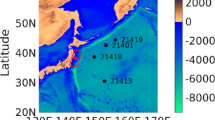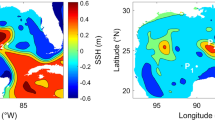Abstract
This work addresses the estimation of the parameters of an earthquake model by the consequent tsunami, with an application to the Chile 2010 event. We are particularly interested in the Bayesian inference of the location, the orientation, and the slip of an Okada-based model of the earthquake ocean floor displacement. The tsunami numerical model is based on the GeoClaw software while the observational data is provided by a single DARTⓇ buoy. We propose in this paper a methodology based on polynomial chaos expansion to construct a surrogate model of the wave height at the buoy location. A correlated noise model is first proposed in order to represent the discrepancy between the computational model and the data. This step is necessary, as a classical independent Gaussian noise is shown to be unsuitable for modeling the error, and to prevent convergence of the Markov Chain Monte Carlo sampler. Second, the polynomial chaos model is subsequently improved to handle the variability of the arrival time of the wave, using a preconditioned non-intrusive spectral method. Finally, the construction of a reduced model dedicated to Bayesian inference is proposed. Numerical results are presented and discussed.
Similar content being viewed by others
References
Abramowitz, M., Stegun, I.A.: Handbook of mathematical functions: with formulas, graphs, and mathematical tables, vol. 55. Courier Corporation (1964)
Alexanderian, A., Le Maître, O.P., Najm, H.N., Iskandarani, M., Knio, O.M.: Multiscale stochastic preconditioners in non-intrusive spectral projection. J. Sci. Comput. 50(2), 306–340 (2012). doi:10.1007/s10915-011-9486-2
American Red Cross Multi-Disciplinary Team: Report on the 2010 Chilean earthquake and tsunami response. Tech. rep., USGS Survey (2011). http://pubs.usgs.gov/of/2011/1053/
Babuška, I., Nobile, F., Tempone, R.: A stochastic collocation method for elliptic partial differential equations with random input data. SIAM Rev. 52(2), 317–355 (2010). doi:10.1137/100786356
Berger, M.J., George, D.L., LeVeque, R.J., Mandli, K.T.: The GeoClaw software for depth-averaged flows with adaptive refinement. Adv. Water Resour. 34(9), 1195–1206 (2011). doi:10.1016/j.advwatres.2011.02.016
Blatman, G., Sudret, B.: Sparse polynomial chaos expansions and adaptive stochastic finite elements using a regression approach. Comptes Rendus Mécanique 336(6), 518–523 (2008). doi:10.1016/j.crme.2008.02.013. http://apps.webofknowledge.com/full_record.do?product=UA&search_mode=GeneralSearch&qid=49&SID=P13PgLmH5nFlA54846F&page=1&doc=2&cacheurlFromRightClick=no http://linkinghub.elsevier.com/retrieve/pii/S1631072108000582
Burnham, K.P., Anderson, D.R. (eds.): Model selection and multimodel inference. Springer New York, New York (2004) http://link.springer.com/10.1007/b97636
Cameron, R.H., Martin, W.T.: The orthogonal development of non-linear functionals in series of fourier-hermite functionals. Ann. Math. 48(2), 385–392 (1947)
Das, S.K., Lardner, R.W.: Variational parameter estimation for a two-dimensional numerical tidal model. Int. J. Numer. Methods Fluids 15(3), 313–327 (1992)
Fukuda, J., Johnson, K.M.: A fully bayesian inversion for spatial distribution of fault slip with objective smoothing. Bull. Seismol. Soc. Amer. 98(3), 1128–1146 (2008)
Gelman, A., Rubin, D.B.: Inference from iterative simulation using multiple sequences. Stat. Sci., 457–472 (1992)
George, D.L.: Augmented Riemann solvers for the shallow water equations over variable topography with steady states and inundation. J. Comput. Phys. 227(6), 3089–3113 (2008). doi:10.1016/j.jcp.2007.10.027
Haario, H., Saksman, E., Tamminen, J.: An adaptive metropolis algorithm. Bernoulli, 223–242 (2001)
Hackbusch, W.: Tensor spaces and numerical tensor calculus, Springer Series in Computational Mathematics, vol. 42. Springer-Verlag, Berlin Heidelberg (2012). http://www.springerlink.com/index/10.1007/978-3-642-28027-6
Heemink, A.W., Mouthaan, E., Roest, M., Vollebregt, E., Robaczewska, K.B., Verlaan, M.: Inverse 3D shallow water flow modelling of the continental shelf. Cont. Shelf Res. 22(3), 465–484 (2002)
Jones, E., Oliphant, T., Peterson, P., et al.: SciPy: Open source scientific tools for Python. http://www.scipy.org/ (2001)
Kass, R.E., Raftery, A.E.: Bayes factors. J. Amer. Stat. Assoc. 90(430), 773–795 (1995)
Kullback, S., Leibler, R.A.: On information and sufficiency. Ann. Math. Stat. 22(1), 79–86 (1951). doi:10.1214/aoms/1177729694
Lardner, R.W., Song, Y.: Optimal estimation of Eddy viscosity and friction coefficients for a quasi-three-dimensional numerical tidal model. Atmosphere-Ocean 33(3), 581–611 (1995)
MacInnes, B.T., Gusman, A.R., LeVeque, R.J., Tanioka, Y.: Comparison of earthquake source models for the 2011 Tohoku event using tsunami simulations and near-field observations. Bull. Seismol. Soc. Amer. 103(2B), 1256–1274 (2013). doi:10.1785/0120120121. http://www.bssaonline.org/cgi/doi/10.1785/0120120121
Marzouk, Y.M., Najm, H.N.: Dimensionality reduction and polynomial chaos acceleration of bayesian inference in inverse problems. J. Comput. Phys. 228(6), 1862–1902 (2009). doi:10.1016/j.jcp.2008.11.024. http://www.sciencedirect.com/science/article/pii/S0021999108006062 http://linkinghub.elsevier.com/retrieve/pii/S0021999108006062
Mayo, T., Butler, T., Dawson, C., Hoteit, I.: Data assimilation within the advanced circulation (adcirc) modeling framework for the estimation of manning’s friction coefficient. Ocean Modell. 76, 43–58 (2014)
Meinig, C., Stalin, S., Nakamura, A., Milburn, H.: Real-time deep-ocean tsunami measuring, monitoring, and reporting system: The NOAA DART II description and disclosure. Tech. rep (2005)
Morariu, V.I., Srinivasan, B.V., Raykar, V.C., Duraiswami, R., Davis, L.S.: Automatic online tuning for fast gaussian summation. In: Advances in Neural Information Processing Systems (2008)
Okada, Y.: Surface deformation due to shear and tensile faults in a half-space. Bull. Seismol. Soc. Amer. 75 (4), 1135–1154 (1985) http://www.bssaonline.org/content/75/4/1135.abstract
Rasmussen, C.E., Williams, C.K.I.: Gaussian processes for machine learning. The MIT Press (2006)
Reagan, M.T., Najm, H.N., Ghanem, R.G., Knio, O.M.: Uncertainty quantification in reacting-flow simulations through non-intrusive spectral projection. Combust. Flame 132(3), 545–555 (2003). doi:10.1016/S0010-2180(02)00503-5 http://www.sciencedirect.com/science/article/pii/S0010218002005035
Sarri, A., Guillas, S., Dias, F.: Statistical emulation of a tsunami model for sensitivity analysis and uncertainty quantification. Nat. Hazards Earth Syst. Sci. 12(6), 2003–2018 (2012). doi:10.5194/nhess-12-2003-2012 http://www.nat-hazards-earth-syst-sci.net/12/2003/2012/
Sraj, I., Mandli, K., Knio, O.M., Hoteit, I.: Uncertainty quantification and inference of Manning’s friction coefficients using DART Buoy data during the Tohoku Tsunami. Ocean Modell. 83, 82–97 (2014). doi:10.1016/j.ocemod.2014.09.001
Sraj, I., Mandli, K., Knio, O.M., Hoteit, I.: Quantifying uncertainties in fault slip distribution during the Tohoku Tsunami using polynomial chaos. Submitted to Ocean Modelling (2016)
Storn, R., Price, K.: Differential evolution – a simple and efficient heuristic for global optimization over continuous spaces. J. Global Optim. 11(4), 341–359 (1997). doi:10.1023/A:1008202821328
Verlaan, M., Heemink, A.W.: Tidal flow forecasting using reduced rank square root filters. Stoch. Hydrol. Hydraul. 11(5), 349–368 (1997)
Wiener, N.: The homogeneous chaos. Amer. J. Math. 60 (4), 897 (1938). doi:10.2307/2371268. http://www.jstor.org/discover/10.2307/2371268?uid=3738016&uid=2129&uid=2&uid=70&uid=4&sid=56294222093 http://www.jstor.org/stable/2371268?origin=crossref
Xiu, D., Karniadakis, G.E.: The Wiener–Askey polynomial chaos for stochastic differential equations. SIAM J. Sci. Comput. 24(2), 619–644 (2002). doi:10.1137/S1064827501387826. http://epubs.siam.org/doi/abs/10.1137/S1064827501387826
Acknowledgments
This work is supported by King Abdullah University of Science and Technology Award CRG3-2156.
Author information
Authors and Affiliations
Corresponding author
Rights and permissions
About this article
Cite this article
Giraldi, L., Le Maître, O.P., Mandli, K.T. et al. Bayesian inference of earthquake parameters from buoy data using a polynomial chaos-based surrogate. Comput Geosci 21, 683–699 (2017). https://doi.org/10.1007/s10596-017-9646-z
Received:
Accepted:
Published:
Issue Date:
DOI: https://doi.org/10.1007/s10596-017-9646-z




